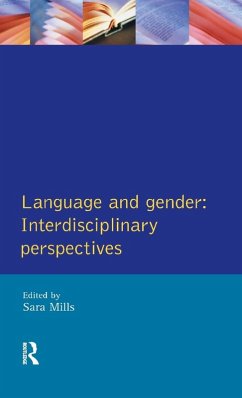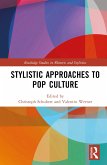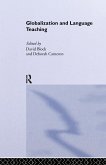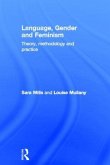- Gebundenes Buch
- Merkliste
- Auf die Merkliste
- Bewerten Bewerten
- Teilen
- Produkt teilen
- Produkterinnerung
- Produkterinnerung
First Published in 1996. Routledge is an imprint of Taylor & Francis, an informa company.
Andere Kunden interessierten sich auch für
![Achieving Understanding Achieving Understanding]() Peter BroederAchieving Understanding132,99 €
Peter BroederAchieving Understanding132,99 €![On Becoming Bilingual On Becoming Bilingual]() Patricia Baquedano-LópezOn Becoming Bilingual174,99 €
Patricia Baquedano-LópezOn Becoming Bilingual174,99 €![Stylistic Approaches to Pop Culture Stylistic Approaches to Pop Culture]() Stylistic Approaches to Pop Culture174,99 €
Stylistic Approaches to Pop Culture174,99 €![The Cultural Politics of English as an International Language The Cultural Politics of English as an International Language]() Alastair PennycookThe Cultural Politics of English as an International Language197,99 €
Alastair PennycookThe Cultural Politics of English as an International Language197,99 €![Globalization and Language Teaching Globalization and Language Teaching]() David Block (ed.)Globalization and Language Teaching187,99 €
David Block (ed.)Globalization and Language Teaching187,99 €![Linguistic Culture and Language Policy Linguistic Culture and Language Policy]() Harold SchiffmanLinguistic Culture and Language Policy187,99 €
Harold SchiffmanLinguistic Culture and Language Policy187,99 €![Language, Gender and Feminism Language, Gender and Feminism]() Sara MillsLanguage, Gender and Feminism187,99 €
Sara MillsLanguage, Gender and Feminism187,99 €-
-
-
First Published in 1996. Routledge is an imprint of Taylor & Francis, an informa company.
Hinweis: Dieser Artikel kann nur an eine deutsche Lieferadresse ausgeliefert werden.
Hinweis: Dieser Artikel kann nur an eine deutsche Lieferadresse ausgeliefert werden.
Produktdetails
- Produktdetails
- Verlag: Taylor & Francis
- Seitenzahl: 296
- Erscheinungstermin: 27. Januar 2017
- Englisch
- Abmessung: 216mm x 140mm x 18mm
- Gewicht: 490g
- ISBN-13: 9781138162273
- ISBN-10: 1138162272
- Artikelnr.: 71557754
- Herstellerkennzeichnung
- Libri GmbH
- Europaallee 1
- 36244 Bad Hersfeld
- gpsr@libri.de
- Verlag: Taylor & Francis
- Seitenzahl: 296
- Erscheinungstermin: 27. Januar 2017
- Englisch
- Abmessung: 216mm x 140mm x 18mm
- Gewicht: 490g
- ISBN-13: 9781138162273
- ISBN-10: 1138162272
- Artikelnr.: 71557754
- Herstellerkennzeichnung
- Libri GmbH
- Europaallee 1
- 36244 Bad Hersfeld
- gpsr@libri.de
Sara Mills
List of Contributors
Acknowledgements
Introduction, Sara Mills
Section 1: Position Papers: Difference or Dominance
1. Language, gender and career, Jennifer Coates
2. Rethinking language and gender studies: some issues for the 1990s,
Deborah Cameron
Section 2: Lesbian Poetics
3. Constructing a lesbian poetic for survival, Liz Yorke
4. Sappho and the other woman, Margaret Williamson
5. `Her wench of bliss: gender and the language of Djuna Barnes' Ladies
Almanack, Deborah Tyler-Bennett
Section 3: Gender/Genre
6. Cyborgs and cyberpunk: rewriting the feminine in popular fiction, Jenny
Wolmark
7. Claiming the speakwrite: linguistic subversion in the feminist dystopia,
Elisabeth Mahoney
Section 4: Gender, Language and Education
8. Feminising classroom talk?, Joan Swann and David Graddol
9. Primary school teachers' explanation of boys' disruptiveness in the
classroom: a gender-specific aspect of the hidden curriculum, Cleopatra
Altani
10. `We're boys, miss!': finding gendered identities and looking for
gendering of identities in the foreign language classroom, Jane Sunderland
Section 5: Gender, Language and Children
11. Dominance and communicative incompetence: the speech habits of a group
of 8-11 year old boys in a Lebanese rural community, Farida Abu-Haidar
12. Voice and gender in children, Alison Lee, Nigel Hewlett and Moray Nairn
Section 6: Language Media/Visual Analysis and Gender
13. Feminism, language and the rhetoric of TV wildlife programmes, Barbara
Crowther and Dick Leith
14. Man in the news: the misrepresentation of women speaking in
news-as-narrative-discourse, Carmen Rosa Caldas-Coulthard
15. Commonplaces: the woman in the street: text and gender in the work of
Jenny Holzer and Barbara Kruger, Helen Mills
Conclusions, Sara Mills
Bibliography
Index
Acknowledgements
Introduction, Sara Mills
Section 1: Position Papers: Difference or Dominance
1. Language, gender and career, Jennifer Coates
2. Rethinking language and gender studies: some issues for the 1990s,
Deborah Cameron
Section 2: Lesbian Poetics
3. Constructing a lesbian poetic for survival, Liz Yorke
4. Sappho and the other woman, Margaret Williamson
5. `Her wench of bliss: gender and the language of Djuna Barnes' Ladies
Almanack, Deborah Tyler-Bennett
Section 3: Gender/Genre
6. Cyborgs and cyberpunk: rewriting the feminine in popular fiction, Jenny
Wolmark
7. Claiming the speakwrite: linguistic subversion in the feminist dystopia,
Elisabeth Mahoney
Section 4: Gender, Language and Education
8. Feminising classroom talk?, Joan Swann and David Graddol
9. Primary school teachers' explanation of boys' disruptiveness in the
classroom: a gender-specific aspect of the hidden curriculum, Cleopatra
Altani
10. `We're boys, miss!': finding gendered identities and looking for
gendering of identities in the foreign language classroom, Jane Sunderland
Section 5: Gender, Language and Children
11. Dominance and communicative incompetence: the speech habits of a group
of 8-11 year old boys in a Lebanese rural community, Farida Abu-Haidar
12. Voice and gender in children, Alison Lee, Nigel Hewlett and Moray Nairn
Section 6: Language Media/Visual Analysis and Gender
13. Feminism, language and the rhetoric of TV wildlife programmes, Barbara
Crowther and Dick Leith
14. Man in the news: the misrepresentation of women speaking in
news-as-narrative-discourse, Carmen Rosa Caldas-Coulthard
15. Commonplaces: the woman in the street: text and gender in the work of
Jenny Holzer and Barbara Kruger, Helen Mills
Conclusions, Sara Mills
Bibliography
Index
List of Contributors
Acknowledgements
Introduction, Sara Mills
Section 1: Position Papers: Difference or Dominance
1. Language, gender and career, Jennifer Coates
2. Rethinking language and gender studies: some issues for the 1990s,
Deborah Cameron
Section 2: Lesbian Poetics
3. Constructing a lesbian poetic for survival, Liz Yorke
4. Sappho and the other woman, Margaret Williamson
5. `Her wench of bliss: gender and the language of Djuna Barnes' Ladies
Almanack, Deborah Tyler-Bennett
Section 3: Gender/Genre
6. Cyborgs and cyberpunk: rewriting the feminine in popular fiction, Jenny
Wolmark
7. Claiming the speakwrite: linguistic subversion in the feminist dystopia,
Elisabeth Mahoney
Section 4: Gender, Language and Education
8. Feminising classroom talk?, Joan Swann and David Graddol
9. Primary school teachers' explanation of boys' disruptiveness in the
classroom: a gender-specific aspect of the hidden curriculum, Cleopatra
Altani
10. `We're boys, miss!': finding gendered identities and looking for
gendering of identities in the foreign language classroom, Jane Sunderland
Section 5: Gender, Language and Children
11. Dominance and communicative incompetence: the speech habits of a group
of 8-11 year old boys in a Lebanese rural community, Farida Abu-Haidar
12. Voice and gender in children, Alison Lee, Nigel Hewlett and Moray Nairn
Section 6: Language Media/Visual Analysis and Gender
13. Feminism, language and the rhetoric of TV wildlife programmes, Barbara
Crowther and Dick Leith
14. Man in the news: the misrepresentation of women speaking in
news-as-narrative-discourse, Carmen Rosa Caldas-Coulthard
15. Commonplaces: the woman in the street: text and gender in the work of
Jenny Holzer and Barbara Kruger, Helen Mills
Conclusions, Sara Mills
Bibliography
Index
Acknowledgements
Introduction, Sara Mills
Section 1: Position Papers: Difference or Dominance
1. Language, gender and career, Jennifer Coates
2. Rethinking language and gender studies: some issues for the 1990s,
Deborah Cameron
Section 2: Lesbian Poetics
3. Constructing a lesbian poetic for survival, Liz Yorke
4. Sappho and the other woman, Margaret Williamson
5. `Her wench of bliss: gender and the language of Djuna Barnes' Ladies
Almanack, Deborah Tyler-Bennett
Section 3: Gender/Genre
6. Cyborgs and cyberpunk: rewriting the feminine in popular fiction, Jenny
Wolmark
7. Claiming the speakwrite: linguistic subversion in the feminist dystopia,
Elisabeth Mahoney
Section 4: Gender, Language and Education
8. Feminising classroom talk?, Joan Swann and David Graddol
9. Primary school teachers' explanation of boys' disruptiveness in the
classroom: a gender-specific aspect of the hidden curriculum, Cleopatra
Altani
10. `We're boys, miss!': finding gendered identities and looking for
gendering of identities in the foreign language classroom, Jane Sunderland
Section 5: Gender, Language and Children
11. Dominance and communicative incompetence: the speech habits of a group
of 8-11 year old boys in a Lebanese rural community, Farida Abu-Haidar
12. Voice and gender in children, Alison Lee, Nigel Hewlett and Moray Nairn
Section 6: Language Media/Visual Analysis and Gender
13. Feminism, language and the rhetoric of TV wildlife programmes, Barbara
Crowther and Dick Leith
14. Man in the news: the misrepresentation of women speaking in
news-as-narrative-discourse, Carmen Rosa Caldas-Coulthard
15. Commonplaces: the woman in the street: text and gender in the work of
Jenny Holzer and Barbara Kruger, Helen Mills
Conclusions, Sara Mills
Bibliography
Index








